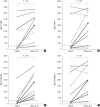Paradoxical increase of IgE binding components during allergen-specific immunotherapy in pollinosis patients
- PMID: 25045240
- PMCID: PMC4101772
- DOI: 10.3346/jkms.2014.29.7.1025
Paradoxical increase of IgE binding components during allergen-specific immunotherapy in pollinosis patients
Abstract
Allergen-specific immunotherapy (SIT) reduces allergen specific IgE (sIgE) levels and achieves clinical and immunological tolerance by modulating innate and adaptive immunological responses. Increased temperature and CO2 concentrations caused by climate changes contribute to an increase of pollen count and allergenicity that influences clinical SIT outcomes. In this study, we investigated the changes of IgE binding components to tree and weed pollens in pollinosis patients who showed a paradoxical increase of serum sIgE level during pollen-SIT. We enrolled nine patients who showed an increasing pattern of serum sIgE level to alder, birch, ragweed and mugwort pollens by enzyme-linked immunosorbant assay. IgE immunoblot analysis confirmed the intensification or new generation of major IgE binding components that could be induced by climate change. The findings suggest that the regular monitoring of sIgE levels and symptom changes is required to improve the clinical outcomes of SIT in patients undergoing SIT for tree and weed pollens.
Keywords: Climate Change; Immunotherapy; Pollinosis; Specific IgE.
Conflict of interest statement
There are no financial or other issues that might lead to conflicts of interest.
Figures


References
Publication types
MeSH terms
Substances
LinkOut - more resources
Full Text Sources
Other Literature Sources
Medical

